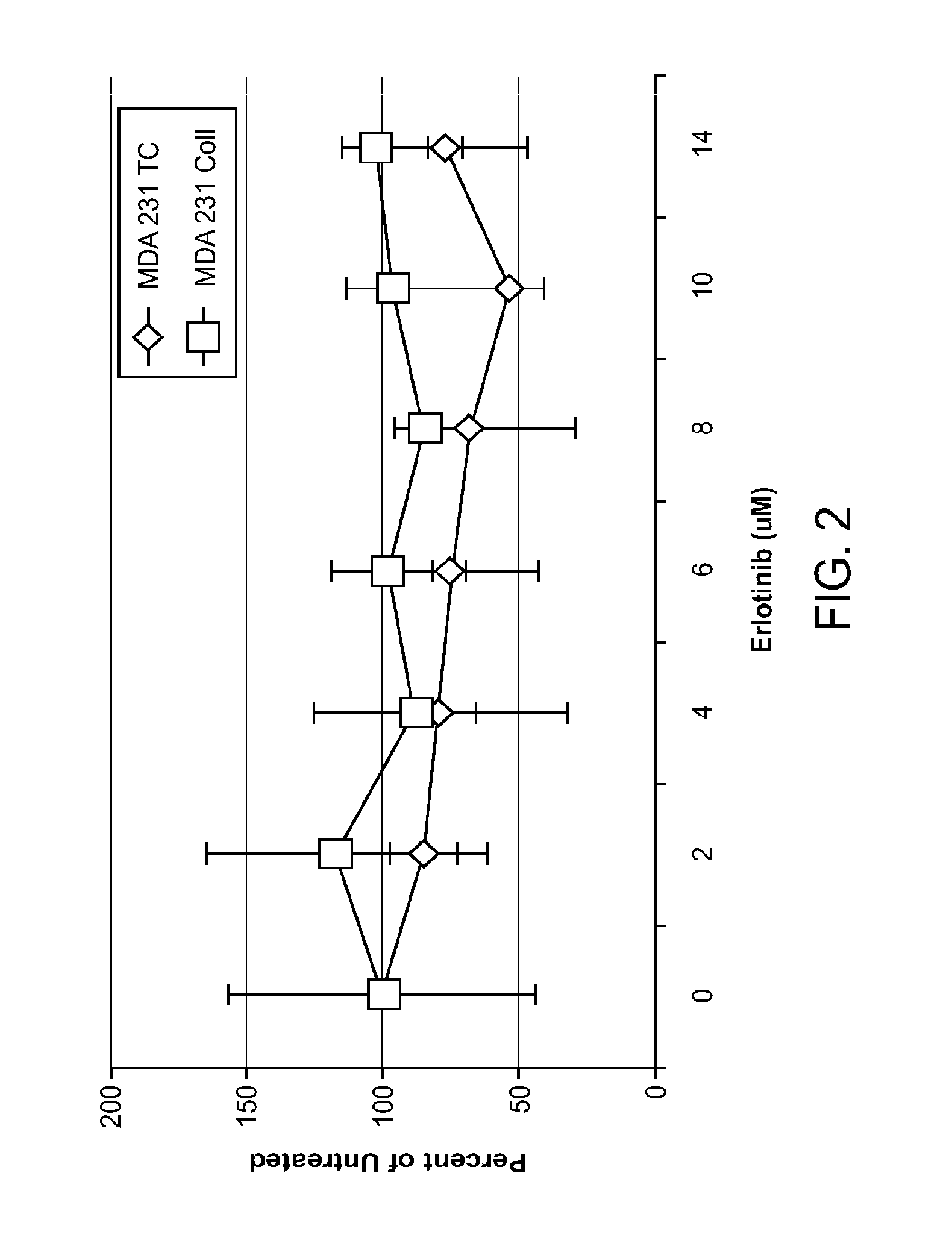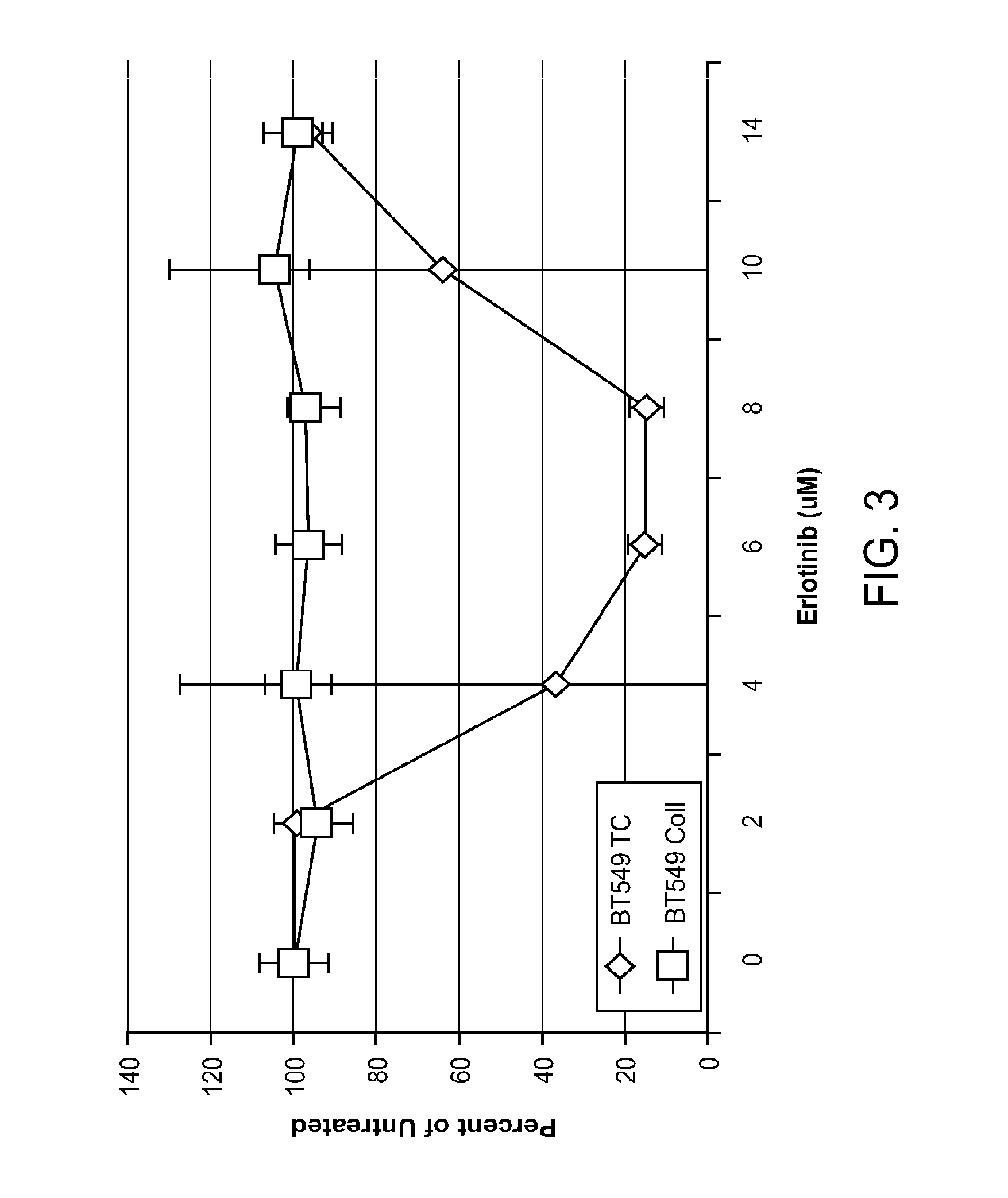Chemotherapeutic methods and compositions
a technology of compositions and chemotherapeutic agents, applied in the field of ##chemotherapeutic and antineoplastic treatments, to achieve the effect of enhancing the enhancing the cell killing activity of an anti-neoplastic agen
- Summary
- Abstract
- Description
- Claims
- Application Information
AI Technical Summary
Benefits of technology
Problems solved by technology
Method used
Image
Examples
example 1
Sensitivity of Tumor Cells to Chemotherapeutic Agents
[0319]This example shows that a number of tumor cell lines are sensitive to various chemotherapeutic agents when grown on standard tissue culture plates. However, when the same cells are grown on tissue culture plates coated with collagen, their sensitivity to the chemotherapeutics is reduced.
[0320]Preparation of Collagen-Coated Cell Culture Vessels
[0321]96-well tissue culture plates coated with collagen Type I were obtained from VWR International (West Chester, Pa.). Alternatively, a 0.5 mg / ml solution of collagen Type I is prepared in 1 mM acetic acid and is filtered through a 0.22 micron membrane. Thirty-three microliters of the collagen solution is added to each well of a 96-well plate. After 30 min, the solution is removed aseptically, and the plate is left to dry in a sterile environment. Plates are stored at 4° C. until use.
[0322]Chemotherapeutic Agents
[0323]Erlotinib is a small molecule chemotherapeutic that targets Epider...
example 2
Effect of siRNA-Mediated Reduction of LOX or LOXL2 Levels on Sensitivity of Tumor Cells to Chemotherapeutic Agents
[0329]This example shows that the resistance to chemotherapeutics, exhibited by tumor cells cultured on collagen, is reversed by reducing levels of LOX or LOXL2 in these cells, using siRNA.
[0330]A short RNA molecule, homologous to sequences in the regions near the 3′ end of LOX mRNA, was obtained from Invitrogen (Carlsbad, Calif.). The sequence of this LOX siRNA was:
[0331]
ACAGGGAUUGAGUCCUGGCUGUUAU(SEQ ID NO.: 1)
[0332]A siRNA homologous to the second SRCR domain of LOXL2 was obtained from Invitrogen (Carlsbad, Calif.) and had the following sequence:
[0333]
UCAACGAAUUGUCAAAUUUGAACCC(SEQ ID NO.: 2)
[0334]A control siRNA, containing a proprietary sequence that is represented to be non-homologous to any sequence in the vertebrate trascriptome, was obtained from Invitrogen (Carlsbad, Calif.).
[0335]MDA231 cells were seeded at 7,500 cells per well in 96-well plates (VWR Internation...
example 3
Inhibition of Lysyl Oxidase-Type Enzymes Reverses the Resistance of Breast Carcinoma Cells to Chemotherapeutic Agents
[0342]This example shows that the resistance to chemotherapeutics, exhibited by BT549 breast carcinoma cells cultured on collagen, is reversed by reducing activity of LOX or LOXL2 in these cells, using antibodies to LOX and LOXL2.
[0343]Antibodies to LOX and LOXL2
[0344]Monoclonal anti-LOX antibodies M64 and M11 are described in co-owned U.S. Patent Application Publication No. 2009 / 0053224 (Feb. 26, 2009), the disclosure of which is incorporated by reference for the purpose of describing these antibodies, their preparation and use.
[0345]Monoclonal anti-LOXL2 antibody M20 is described in co-owned U.S. Patent Application Publication No. 2009 / 0053224 (Feb. 26, 2009), the disclosure of which is incorporated by reference for the purpose of describing this antibody, its preparation and use.
[0346]Sensitivity of Breast Carcinoma Cells to Chemotherapeutics in the Presence of Lys...
PUM
 Login to View More
Login to View More Abstract
Description
Claims
Application Information
 Login to View More
Login to View More - R&D
- Intellectual Property
- Life Sciences
- Materials
- Tech Scout
- Unparalleled Data Quality
- Higher Quality Content
- 60% Fewer Hallucinations
Browse by: Latest US Patents, China's latest patents, Technical Efficacy Thesaurus, Application Domain, Technology Topic, Popular Technical Reports.
© 2025 PatSnap. All rights reserved.Legal|Privacy policy|Modern Slavery Act Transparency Statement|Sitemap|About US| Contact US: help@patsnap.com



